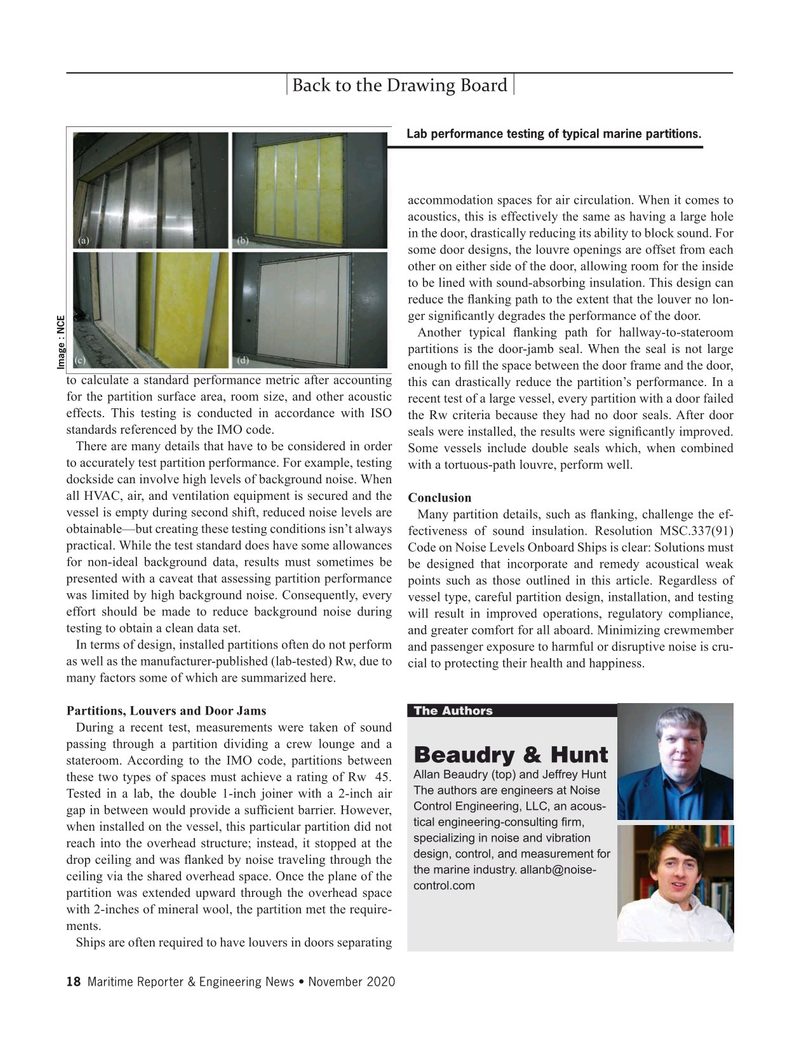
Page 18: of Maritime Reporter Magazine (November 2020)
Workboat Edition
Read this page in Pdf, Flash or Html5 edition of November 2020 Maritime Reporter Magazine
Back to the Drawing Board
Lab performance testing of typical marine partitions.
accommodation spaces for air circulation. When it comes to acoustics, this is effectively the same as having a large hole in the door, drastically reducing its ability to block sound. For some door designs, the louvre openings are offset from each other on either side of the door, allowing room for the inside to be lined with sound-absorbing insulation. This design can reduce the ? anking path to the extent that the louver no lon- ger signi? cantly degrades the performance of the door.
Another typical ? anking path for hallway-to-stateroom partitions is the door-jamb seal. When the seal is not large
Image : NCE enough to ? ll the space between the door frame and the door, to calculate a standard performance metric after accounting this can drastically reduce the partition’s performance. In a for the partition surface area, room size, and other acoustic recent test of a large vessel, every partition with a door failed effects. This testing is conducted in accordance with ISO the Rw criteria because they had no door seals. After door standards referenced by the IMO code.
seals were installed, the results were signi? cantly improved.
There are many details that have to be considered in order Some vessels include double seals which, when combined to accurately test partition performance. For example, testing with a tortuous-path louvre, perform well.
dockside can involve high levels of background noise. When all HVAC, air, and ventilation equipment is secured and the Conclusion vessel is empty during second shift, reduced noise levels are
Many partition details, such as ? anking, challenge the ef- obtainable—but creating these testing conditions isn’t always fectiveness of sound insulation. Resolution MSC.337(91) practical. While the test standard does have some allowances Code on Noise Levels Onboard Ships is clear: Solutions must for non-ideal background data, results must sometimes be be designed that incorporate and remedy acoustical weak presented with a caveat that assessing partition performance points such as those outlined in this article. Regardless of was limited by high background noise. Consequently, every vessel type, careful partition design, installation, and testing effort should be made to reduce background noise during will result in improved operations, regulatory compliance, testing to obtain a clean data set.
and greater comfort for all aboard. Minimizing crewmember
In terms of design, installed partitions often do not perform and passenger exposure to harmful or disruptive noise is cru- as well as the manufacturer-published (lab-tested) Rw, due to cial to protecting their health and happiness. many factors some of which are summarized here.
The Authors
Partitions, Louvers and Door Jams
During a recent test, measurements were taken of sound passing through a partition dividing a crew lounge and a
Beaudry & Hunt stateroom. According to the IMO code, partitions between
Allan Beaudry (top) and Jeffrey Hunt these two types of spaces must achieve a rating of Rw 45.
The authors are engineers at Noise
Tested in a lab, the double 1-inch joiner with a 2-inch air
Control Engineering, LLC, an acous- gap in between would provide a suf? cient barrier. However, tical engineering-consulting ? rm, when installed on the vessel, this particular partition did not specializing in noise and vibration reach into the overhead structure; instead, it stopped at the design, control, and measurement for drop ceiling and was ? anked by noise traveling through the the marine industry. allanb@noise- ceiling via the shared overhead space. Once the plane of the control.com partition was extended upward through the overhead space with 2-inches of mineral wool, the partition met the require- ments.
Ships are often required to have louvers in doors separating 18 Maritime Reporter & Engineering News • November 2020
MR #11 (18-33).indd 18 11/9/2020 9:29:14 AM

 17
17

 19
19
